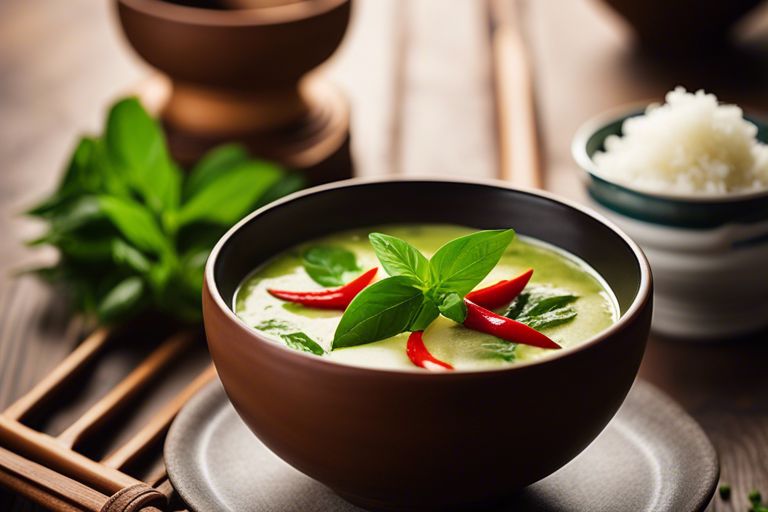Delve into the exquisite world of Thai cuisine with our comprehensive guide on mastering the flavorful and aromatic Green Curry. This coconut milk-based dish is a staple in Thailand known for its harmonious blend of spices and herbs. In this tutorial, we will walk you through the traditional ingredients, cooking techniques, and pro tips to help you achieve the perfect Green Curry right in your own kitchen. Get ready to elevate your culinary skills and impress your taste buds with this authentic taste of Thailand.
Essential Ingredients
Green Curry Paste Composition
While mastering the art of making green curry, understanding the composition of the green curry paste is crucial. This paste is a blend of fresh green chilies, lemongrass, garlic, shallots, galangal, kaffir lime peel, coriander roots, cumin seeds, peppercorns, and shrimp paste.
Types of Coconut Milk and Their Impact on Flavor
Now, let’s research into the types of coconut milk available and how they can influence the flavor of your green curry. Coconut milk can range from thick and creamy to light and watery, impacting the richness and consistency of your curry.
| Green | Coconut Milk Types |
| 1 | Full-fat Coconut Milk |
| 2 | Coconut Cream |
| 3 | Lite Coconut Milk |
| 4 | Coconut Milk Powder |
| 5 | Homemade Coconut Milk |
Understanding the differences between these types of coconut milk is necessary as they can vastly alter the taste and texture of your green curry. Knowing when to use each type can make a significant difference in your final dish.
Impact
The impact of using different types of coconut milk in your green curry recipe cannot be overstated. Full-fat coconut milk will result in a richer and creamier curry, while lite coconut milk will produce a lighter and less caloric version. It’s crucial to select the right type of coconut milk based on your preference for the consistency and richness of the curry.
| Impact | Types of Coconut Milk |
| 1 | Full-fat |
| 2 | Coconut Cream |
| 3 | Lite |
| 4 | Powder |
| 5 | Homemade |
Preparing Your Kitchen
Necessary Cookware and Tools
Your journey to mastering green curry begins with having the right cookware and tools in your kitchen. You will require a medium-sized saucepan or a wok, a sharp knife for chopping ingredients, a cutting board, and a stirring spoon. Having these basic items will make the cooking process smooth and enjoyable.
Pre-preparation Tips for Ingredients
Your ingredients play a crucial role in the flavors of your green curry. Pre-preparation is key to ensuring a delicious outcome. Wash and chop your vegetables, dice your protein of choice, and measure out your coconut milk and curry paste before starting to cook. This will save you time and prevent any last-minute rush in the kitchen.
Little Extra Tip:
- Preparing your ingredients in advance allows you to focus on the cooking process and ensures that everything is ready to go when needed.
Necessary precautions should also be taken with your ingredients, such as checking for freshness and properly storing them to maintain their quality. Make sure your vegetables are crisp and protein is fresh before using them in your green curry.
Step-by-Step Cooking Guide
Many beginners may feel intimidated by the thought of making Green Curry from scratch, but fear not! With this step-by-step cooking guide, you’ll be able to master this delicious coconut milk-based curry from Thailand in no time.
| Step 1: Making the Green Curry Paste | Step 2: Cooking Techniques for Green Curry |
| For the perfect Green Curry, start by making your own homemade Green Curry Paste using fresh ingredients like lemongrass, green chilies, coriander roots, garlic, shallots, and more. | Curry techniques play a crucial role in developing the flavors of Green Curry. From blooming the spices in hot oil to simmering the curry gently, each step contributes to the final taste. |
Step 3: Balancing Spices and Seasonings
The key to a well-rounded Green Curry is finding the right balance of spices and seasonings. Taste as you go and adjust the levels of salt, sugar, fish sauce, and lime juice to achieve the perfect harmony of flavors.
The art of balancing spices and seasonings in Green Curry is important to elevate the dish from good to exceptional. Plus, understanding the role of each ingredient will help you customize the curry to suit your taste preferences.
Step 4: Incorporating Protein and Vegetables
Curry becomes a complete meal when you add protein and vegetables. Whether you prefer chicken, shrimp, tofu, or a mix of veggies, make sure to cook them just right so they complement the flavors of the Green Curry.
Green Curry reaches its full potential when you carefully choose and prepare the protein and vegetables to go into the dish. Recall, the quality of these ingredients can make or break your curry!
Step 5: Finishing with the Perfect Texture
If you want to achieve the perfect Green Curry, pay attention to the texture. Ensure that the curry is not too thick or too watery by adjusting the amount of coconut milk and broth accordingly.
Vegetables should be cooked to perfection to add a delightful crunch and freshness to your Green Curry. Don’t overcook them; they should be tender yet still have a bite to them.
Serving and Pairing
Traditional Accompaniments
Accompaniments are an crucial part of serving green curry in Thailand. Traditional accompaniments include steamed jasmine rice, which helps balance the spiciness of the curry with its fragrant and fluffy texture. Additionally, freshly sliced cucumber, Thai basil leaves, and lime wedges are often served on the side to add brightness and freshness to the dish.
Modern Twists on Serving Green Curry
One modern twist on serving green curry is to pair it with quinoa or cauliflower rice for a healthier and grain-free option. Another contemporary approach is to serve the curry in mini coconut bowls for a visually appealing presentation. Experiment with toppings like crispy fried shallots, toasted coconut flakes, or a sprinkle of crushed peanuts to add texture and depth of flavor to the dish.
To elevate the presentation of green curry, you can also try serving it in hollowed-out pineapple halves or coconut shells for a tropical touch. These creative serving ideas not only make your dish Instagram-worthy but also enhance the overall dining experience for your guests.
Preserving and Storing
Best Practices for Leftovers
One of the best ways to preserve the flavors of your green curry is by properly storing leftovers. It is imperative to transfer any remaining curry into an airtight container and refrigerate it promptly. Ideally, leftovers should be consumed within 2-3 days to ensure the best taste and quality.
Freezing and Reheating Tips
With green curry being a dish that can easily be frozen, reheated, and enjoyed later, here are some helpful tips to make the process seamless. Always allow the curry to cool down to room temperature before transferring it to a freezer-safe container. Label the container with the date to track its freshness. When reheating, slowly thaw the curry in the refrigerator overnight or on low heat on the stovetop. Stirring occasionally will help distribute the heat evenly and maintain the flavors.
- Any leftovers that have been frozen and reheated should be consumed promptly within 1-2 days to retain optimal taste.
Common Mistakes to Avoid
Over or Under Cooking Ingredients
Now, one of the common mistakes to avoid when making green curry is over or under cooking the ingredients. Vegetables should be cooked until they are tender but still retain some crunch, while meats should be cooked through but not overdone. Finding the right balance is key to a successful green curry.
Spice Level Adjustments
Now, when it comes to adjusting the spice level in green curry, it’s important to do so carefully. Adding too much spice can overpower the dish, while adding too little can result in a bland curry. Tasting as you go and gradually adding small amounts of spice is the best way to achieve the perfect balance of flavors.
An vital tip for adjusting the spice level is to start with a little and then gradually increase until you reach your desired level of heat. Bear in mind, you can always add more spice, but you can’t take it out once it’s in there. Be cautious and attentive throughout the process to ensure you achieve the ideal level of spiciness for your green curry.
Conclusion
To wrap up, mastering the art of Green Curry is a wonderful culinary achievement that involves balancing the intricate flavors of coconut milk, fresh herbs, and spices. By understanding the key ingredients, techniques, and tips provided in this guide, you can confidently create a delicious and authentic Green Curry that transports you to the vibrant streets of Thailand. With practice and experimentation, you will be able to personalize your curry to suit your taste preferences and impress your friends and family with a truly homemade Thai delicacy.













Comments are closed